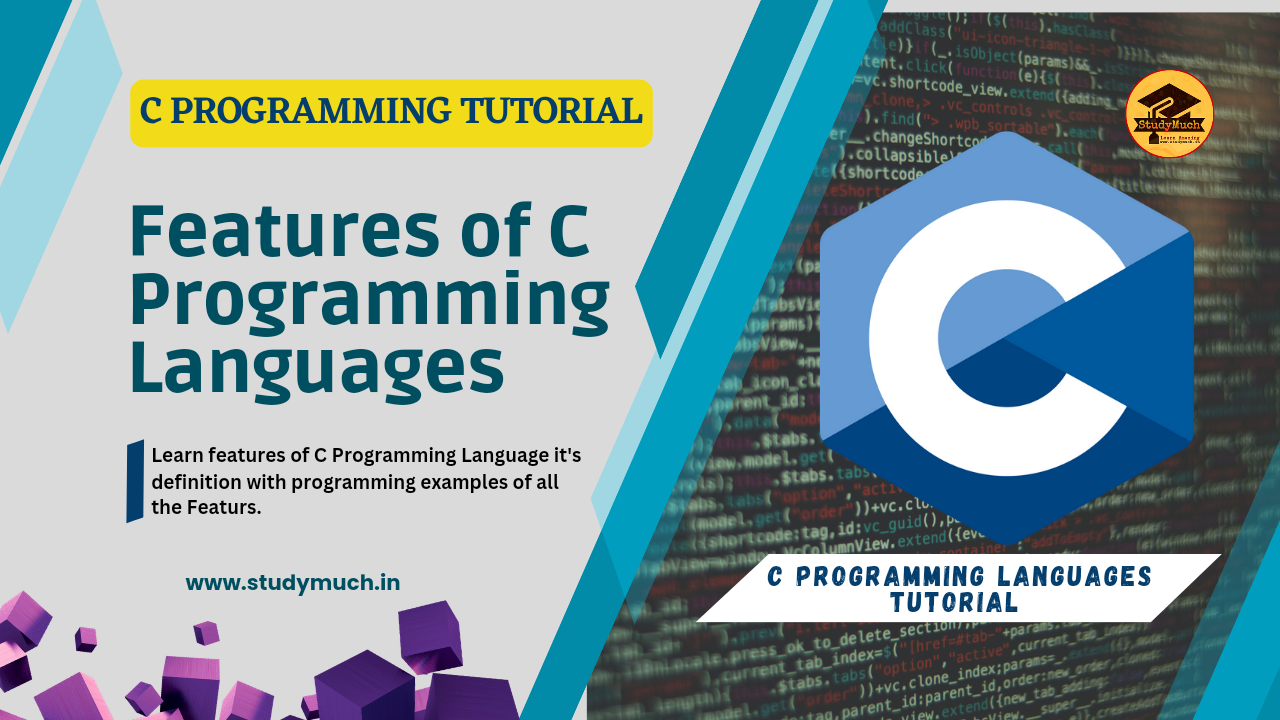Features of C Language

Features of C Language
C language is a high-level programming language that was originally developed in the early 1970s by Dennis Ritchie at Bell Labs. It is widely used in various fields of computer programming, such as systems programming, embedded programming, and scientific computing. C language has many features that make it a popular choice among programmers. In this blog post, we will learn the features of the C language and provide examples of each feature.
Features of C Programming Languages.
- Simple and Easy-to-Learn
- Structured Programming
- Portability
- Extensibility
- Pointers
- Low-Level Language Features
- Flexibility

Now learn description of all the features of C programming language in details with examples.
1. Simple and Easy to Learn:
C language has a simple and easy-to-learn syntax, which makes it an ideal language for beginners. The syntax of C language is similar to that of English language, which makes it easier to understand and write.
Here is an example of a simple C program:
#include <stdio.h> int main() { printf("Hello, World!"); return 0; }
This program prints the message “Hello, World!” on the screen.
2. Structured Language:
C language is a structured programming language, which means that the program is divided into small modules or functions. Each function performs a specific task, and the functions are called from the main program. This feature helps in reducing the complexity of the program and makes it easier to understand and modify.
Here is an example of a structured C program:
#include <stdio.h> int sum(int a, int b) {return a + b;} int main() { int a = 5, b = 10; int result = sum(a, b); printf("Sum of %d and %d is %d", a, b, result); return 0; }
This program calculates the sum of two numbers using a function called sum().
3. Portability:
C language is a highly portable language, which means that it can be compiled and executed on different platforms and operating systems without any changes in the code. This feature makes it a popular choice for cross-platform development.
Here is an example of a portable C program:
#include <stdio.h> int main() { printf("Size of int: %d bytes\n", sizeof(int)); printf("Size of float: %d bytes\n", sizeof(float)); printf("Size of double: %d bytes\n", sizeof(double)); return 0; }
This program prints the sizes of int, float, and double data types on the screen.
4. Rich Library:
C language has a rich library of built-in functions and data types, which makes it easier to perform complex tasks such as file handling, string manipulation, and math calculations.
Here is an example of using the sqrt() function from the math library:
#include <stdio.h> #include <math.h> int main() { double num = 25; double result = sqrt(num); printf("Square root of %lf is %lf", num, result); return 0; }
This program calculates the square root of a number using the sqrt() function from the math library.
5. Pointers:
C language supports pointers, which are variables that store the memory address of another variable. Pointers are used for memory manipulation and dynamic memory allocation.
Here is an example of using a pointer to swap the values of two variables:
#include <stdio.h> void swap(int *a, int *b) { int temp = *a; *a = *b; *b = temp; } int main() { int a = 5, b = 10; printf("Before swap: a = %d, b = %d\n", a, b); swap(&a, &b); printf("After swap: a = %d , b = %d\n", a, b); return 0; }
This program demonstrates the use of pointers in C to swap the values of two variables.
6. Low-Level Language Features:
C language also has low-level language features such as direct memory access and bit manipulation, which allows programmers to write efficient code for systems programming and embedded programming.
Here is an example of using bit manipulation to set and clear the bits of an integer variable:
#include <stdio.h> #define SET_BIT(x, y) (x |= (1 << y)) #define CLEAR_BIT(x, y) (x &= ~(1 << y)) int main() { int num = 10; printf("Binary representation of %d: %b\n", num, num); SET_BIT(num, 1); printf("Binary representation after setting bit 1: %b\n", num); CLEAR_BIT(num, 0); printf("Binary representation after clearing bit 0: %b\n", num); return 0; }
This program sets and clears the bits of an integer variable using bit manipulation macros.
7. Flexibility:
C language is a flexible language that allows programmers to write code in different styles, such as procedural, object-oriented, and functional programming. This feature makes it a versatile language that can be used in different types of projects.
Here is an example of using C language for object-oriented programming:
#include <stdio.h> typedef struct { int width; int height;} Rectangle; int area(Rectangle r) { return r.width * r.height; } int main() { Rectangle r = {5, 10}; printf("Area of rectangle with width %d and height %d is %d", r.width, r.height, area(r)); return 0; }
This program defines a rectangle structure and calculates its area using a function.
In conclusion, C language has many features that make it a popular choice among programmers. It is a simple and easy-to-learn language, supports structured programming, is highly portable, has a rich library of built-in functions, supports pointers and low-level language features, and is flexible enough to support different programming styles. If you are planning to learn programming, C language is a great language to start learning programming journey.
So, in this tutorial you have learned Features of C programming language with its programming examples of all the features. I hope you understood this tutorial well, and if you have any doubt about regarding this then you can ask in the comment section.
Learn More;


0 Comments